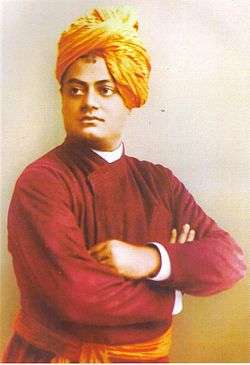Ramakrishna Mission Vivekananda Educational and Research Institute
 | |
Former names | Ramakrishna Mission Vivekananda University |
|---|---|
Motto in English | For one's own salvation and for the welfare of the world |
| Type | Deemed University |
| Established | 2005 |
Parent institution | Ramakrishna Mission |
| Chancellor | Swami Suvirananda |
| Vice-Chancellor | Swami Atmapriyananda[1] |
| Location | Belur, West Bengal, 711202, India |
| Affiliations | UGC |
| Website | http://www.rkmvu.ac.in/ |
Ramakrishna Mission Vivekananda Educational and Research Institute, formerly Ramakrishna Mission Vivekananda University or simply Vivekananda University, is a deemed university headquartered at Belur, West Bengal, with campuses spanning multiple states in India. Established with the idea of actualizing Swami Vivekananda's vision of education, the Institute is administered by the Ramakrishna Mission.
The university provides courses on subjects as varied as rural and tribal development, disability management and special education, fundamental science education and Indian cultural and spiritual heritage. These courses are conducted through specialized faculty centers housed in the various campuses. Some of the unconventional areas of study and research covered by the faculty centers of the university include disability management and special education at Coimbatore and integrated rural development including tribal development and management at its centers in Ranchi and Narendrapur.
History
Ramakrishna Mission Vivekananda Educational and Research Institute was established with the idea of actualizing Swami Vivekananda's vision of education.[2] It was declared as a de novo Deemed University by the Ministry of Human Resource Development, Government of India in 2005. With its headquarters at Belur, RKMVERI began functioning in July 2005 with one branch in the Specialized Faculty Centre at Coimbatore in the field of ‘Disability Management and Special Education’. In the following year, three new branches were added at Narendrapur, Ranchi and Kolkata (at Simla – the ancestral residence of Swami Vivekananda, currently operating under the Belur main campus).[3]
Since then, two new schools have been established in the main campus, namely the School of Mathematical Sciences (focusing on mathematics, theoretical physics and theoretical computer science), and the School of Indian Heritage (including Sanskrit studies, ancient Indian heritage and Vedanta, especially the Upanishads and the Bhagavad Gita).

Highlights
- RKMVERI hosts a special UNESCO chair in the area of Inclusive Adapted Physical Education and Yoga. The chair was established in 2012.[4]
- The Faculty of Disability Management and Special Education (FDMSE) at the Coimbatore campus has produced a comprehensive Indian Sign Language (ISL) dictionary addressing the communicative need of persons with hearing impairment.[5] FDMSE also houses a Braille printing press.[6]
Notable faculty
- Mahan Maharaj, awarded the 2011 Shanti Swarup Bhatnagar Prize for Science and Technology[7]
- Swami Samarpanananda, writer and a monk of Ramakrishna Mission[8]
- Narasimhaiengar Mukunda, Indian physicist, Shanti Swarup Bhatnagar awardee[9]
References
- ↑ "Administration | Ramakrishna Mission Vivekananda Educational and Research Institute". rkmvu.ac.in.
- ↑ "Swamiji's vision turns into varsity". Telegraph India. 5 July 2005. Retrieved 20 April 2018.
- ↑ "History". www.vivekanandauniversity-cbe.org. Retrieved 20 April 2018.
- ↑ Dutta, Indrani (29 December 2015). "Ramakrishna Mission-UNESCO establish 'official ties'". The Hindu. Retrieved 20 April 2018.
- ↑ Ananth, M. K. (5 February 2016). "English, Hindi sign language dictionary to be released today". The Hindu. Retrieved 20 April 2018.
- ↑ "National Institute for the Visually Handicapped Annual Report 2012–13" (PDF). p. 90.
- ↑ "Vidyanathananda, the wizard who became a monk". The Times of India. Retrieved 2018-04-15.
- ↑ SiliconIndia. "IITians and IIM grads seek career in spiritualism". siliconindia. Retrieved 2018-04-15.
- ↑ "Faculty | Department of Physics, RKMVERI". physics.rkmvu.ac.in. Retrieved 2018-05-14.
External links
